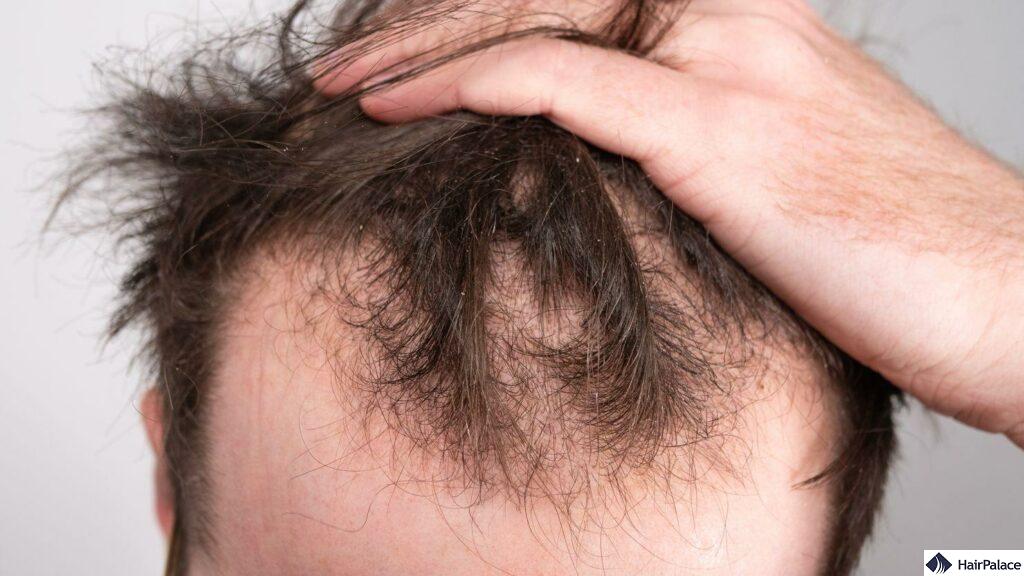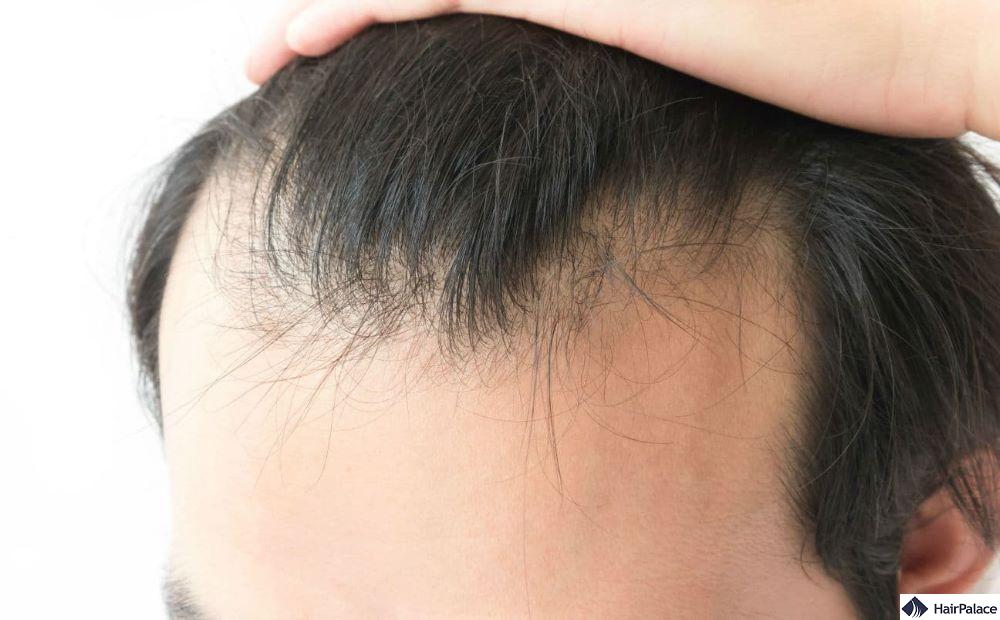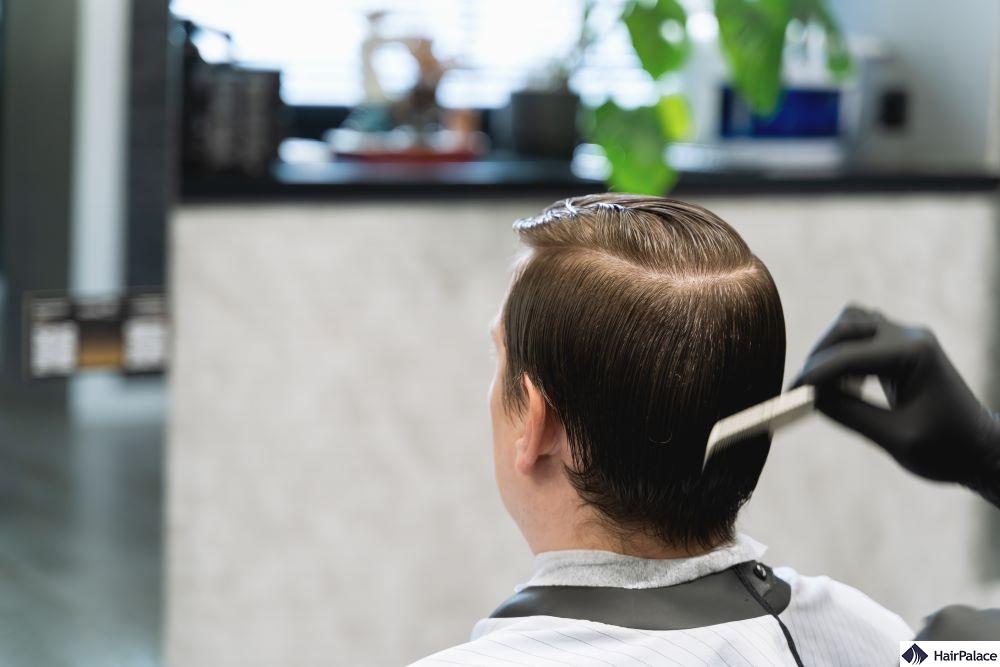Middle Hair Parting for Men

Men’s hair parting significantly influences overall appearance, confidence, and style.
One of the most iconic and timeless styles is the middle parting.
It’s a versatile option with various hair textures and lengths, offering modern appeal and nostalgic charm.
This article will guide you through everything you need to know about hair parting for men.
From exploring the benefits of a middle parting to practical tips for hiding hair loss, and learning where your hair naturally parts you’ll find a wealth of insights to help you achieve your ideal look.
No matter where you’re in your hair journey, this guide will equip you with the knowledge and techniques to rock a stylish, confident hair parting.
- Middle parting hair male
- Benefits of a Middle Parting Hairstyle
- How to Achieve a Middle-Parting Hairstyle
- Why is my hair parting thinning?
- Why has my hair started parting in the back?
- Middle parting men’s hair ideas to hide your hair loss
- Tips to Hide Hair Loss with a Middle Part
Middle parting hair male

A middle parting hairstyle for males is a versatile and stylish option that involves parting the hair directly down the centre of the scalp.
This look can suit various hair types and face shapes, offering a balanced and symmetrical appearance.
Whether you have naturally curly hair with an oval face shape or straight hair with a heart-shaped face it is the perfect option for a stylish look.
Benefits of a Middle Parting Hairstyle
A centre part creates symmetry, enhancing facial features and providing a harmonious look.
It also requires minimal styling tools and products, especially for those with naturally straight or wavy hair.
Suitable for both casual and formal settings, making it easy to adapt to different occasions.
It is currently popular among celebrities and fashion-forward individuals, giving a contemporary edge to your style.
How to Achieve a Middle-Parting Hairstyle
First, ensure your hair is long enough to part in the middle comfortably.
Then use a comb to draw a straight line from the front hairline to the crown. If you prefer a sharper parting you may use a fine-tooth comb.
It’s always best to get advice from your hairdresser on how to best part your hair, they can easily help you find where your hair parts naturally.
Get your hair trimmed regularly to prevent split ends and maintain a stylish look.
You should also remember that a middle part requires a certain level of hair density and growth on both sides.
While generally low-maintenance, achieving a perfectly straight part may require some effort and regular upkeep.
Why is my hair parting thinning?

Hair thinning in this area can be concerning, but understanding the underlying causes can help you address the issue effectively and head forward with the right approach.
1. Androgenetic Alopecia (Male or Female Pattern Baldness)
This is the most common cause of hair thinning and is influenced by genetics and hormones.
It manifests as gradual thinning along the hairline and crown in men and overall thinning in women.
Treatments include minoxidil (Rogaine), finasteride (Propecia) for men, and other therapies like platelet-rich plasma (PRP) or hair transplants.
2. Traction Alopecia
Traction alopecia is caused by repeated tension or pulling on the hair follicles.
It typically occurs due to hairstyles that pull the hair tight, such as ponytails, braids, or extensions.
Try changing hairstyles to reduce tension, use gentle hair care practices, and allow the hair to recover.
3. Nutritional Deficiencies
Lack of essential nutrients can weaken hair follicles.
Iron, vitamin D, biotin, zinc, and protein are all crucial for healthy hair growth.
Ensure a balanced diet rich in these nutrients or consider supplements after consulting with a healthcare provider.
4. Stress and Hormonal Changes

Physical or emotional stress can trigger temporary hair loss conditions like telogen effluvium.
This results in diffuse thinning across the scalp, including the parting area.
Stress management techniques such as meditation, exercise, and adequate sleep can help. In some cases, medical treatment may be necessary.
5. Medical Conditions and Medications
Thyroid disorders, autoimmune diseases (like alopecia areata), and scalp infections can cause hair thinning.
Certain drugs, including those for cancer, arthritis, depression, and heart problems, may have side effects that include hair loss.
Consult with a healthcare provider to review medications and treat any underlying medical conditions.
6. Aging
As you age, hair naturally becomes thinner and may recede.
While ageing is a natural process, maintaining a healthy lifestyle and using appropriate hair care products can help manage thinning hair.
7. Hair Care Practices
Overuse of heat styling tools, harsh chemical treatments, and improper handling can damage hair and lead to thinning.
Adopt gentle hair care routines, minimize the use of heat and chemicals, and use protective hairstyles.
8. Genetics
Family history plays a significant role in hair thinning and loss patterns.
Although you can’t change your genetics, you can take proactive steps with treatments and healthy hair practices to slow down the process.
Why has my hair started parting in the back?
A shifting hair part can be concerning, but understanding the possible reasons behind it can help you address the issue effectively.
It can result from various factors, including hair thinning, styling practices, hormonal changes, and genetic predispositions.
Identifying the underlying cause is crucial for effective management and treatment.
We recommend scheduling an appointment with a healthcare professional or a specialist in hair health to receive a personalized diagnosis and treatment plan tailored to your specific needs.
Middle parting men’s hair ideas to hide your hair loss

If you’re experiencing hair loss but still want to rock a middle parting hairstyle, there are several smart ways to style your hair.
These techniques can create the illusion of thicker, fuller hair.
1. Textured Crop with Middle Part
An excellent choice for those with a diamond-shaped face, though it can be a stylish look for most.
The texture adds volume and conceals thinning spots, especially at the crown or parting line.
By keeping the hair slightly messy and tousled, you draw attention away from the scalp.
Use a lightweight texturizing spray or matte clay, to create a subtle, uneven middle part that blends naturally with the texture.
2. Curtain Bangs
Curtain bangs use longer hair at the front, which naturally frames the face while covering areas of hair loss along the temples and hairline.
This works great if you have a square face shape.
Grow out the front hair to about eyebrow or eye level, then part the hair in the middle with a round brush and hairdryer to create a sweeping effect.
Finish with a light-hold mousse or volumizing spray to keep the bangs in place.
This draws more attention to your face and bone structure making it an especially popular choice among younger generations.
3. Middle Part with Undercut
It adds height and structure, making it perfect for round face shapes.
By shaving the sides and back, you create a stark contrast that makes the hair on top appear fuller and thicker.
The middle part allows for longer hair on top, which you can style to cover problem areas.
4. Wavy Middle Part
Wavy hair has natural volume and texture, making it harder to see thinning spots along the parting line.
This natural “chaos” effect hides areas of hair loss while still looking stylish.
Apply a curl-enhancing cream if your waves need extra definition.
For additional styling, opt for a wide-toothed comb.
5. Slicked Back Middle Part
Although this look exposes the scalp more, using the right product can make hair appear thicker.
Products like pomade or styling gel add shine, and slicking the hair back creates the appearance of more density.
Slick the hair back with a comb, or just your hand and let it dry naturally for a glossy finish.
6. Long, Shaggy Middle Part

Longer layers naturally create volume and movement, which can mask thinning areas especially if you have a long face shape.
The middle part draws the hair forward to frame the face, covering up the hairline and parting and adding a sense of more volume.
Finger-comb your hair to create an imperfect, natural middle part.
7. Low-Key Middle Part
This look uses a soft, barely noticeable part rather than a sharp, defined line. This creates the illusion of density at the roots.
Use your fingers (not a comb) to loosely part your hair in the middle.
Apply a dry shampoo or volumizing spray to give your roots lift and density.
Style the rest of the hair with light, natural waves for a casual, lived-in look.
8. Short Middle Part (Mini-Curtain Look)
This modern, shorter take on the classic curtain style avoids the need for excessive length while still using the natural part to add volume.
This works especially well for men with thinning hairlines, as the focus remains on the centre.
9. Side-Swept Middle Part (The “Hybrid Part”)
A side-swept middle part lets you create the look of a middle part but with an angled, sweeping direction.
This hides thinning areas and offers the same stylish, casual effect as a side part.
Create a slightly off-centre part using your fingers, but brush the hair forward and to the side.
10. Faux Middle Part (Hidden Hair Part)
This look creates the illusion of a middle part without fully parting the hair.
It works by using volume and lift at the roots, giving a “natural, unintentional part” look that hides the appearance of thinness.
Blow-dry your hair while brushing it back to avoid creating a clear part.
Tips to Hide Hair Loss with a Middle Part
- Use Volume-Boosting Products: Look for lightweight, volumizing powders, mousses, or sprays to create lift at the roots.
- Avoid Sharp, Clean Parts: A sharp part can highlight thinning areas. Opt for different hairstyles that offer softer, more natural parts created with fingers instead of a comb.
- Dry Shampoo as a Secret Weapon: It absorbs oil and adds volume, making your hair appear thicker.
- Consider a Hair Transplant: A hair transplant could restore the density at your parting line if you’re dealing with significant thinning.
- Use Hair Fibers: Hair-thickening fibres (like Toppik) can be sprinkled on thinning areas to give the illusion of fuller hair.
- Consult a Trichologist: If the thinning is severe, it may be time to explore hair growth treatments or professional interventions like PRP therapy.
- Sinclair RD. Healthy hair: what is it? J Investig Dermatol Symp Proc. 2007 Dec;12(2):2-5. doi: 10.1038/sj.jidsymp.5650046. PMID: 18004288.https://pubmed.ncbi.nlm.nih.gov/18004288/
- Koch SL, Tridico SR, Bernard BA, Shriver MD, Jablonski NG. The biology of human hair: A multidisciplinary review. Am J Hum Biol. 2020 Mar;32(2):e23316. doi: 10.1002/ajhb.23316. Epub 2019 Sep 3. PMID: 31479564.https://pubmed.ncbi.nlm.nih.gov/31479564/
- Hillmann K, Blume-Peytavi U. Diagnosis of hair disorders. Semin Cutan Med Surg. 2009 Mar;28(1):33-8. doi: 10.1016/j.sder.2008.12.005. PMID: 19341940.https://pubmed.ncbi.nlm.nih.gov/19341940/


